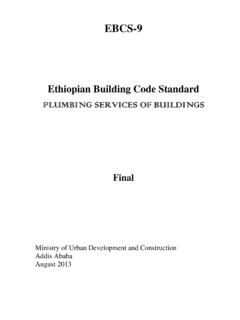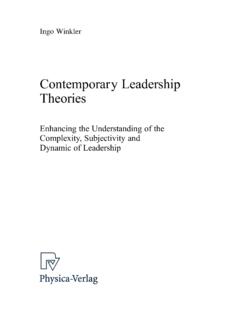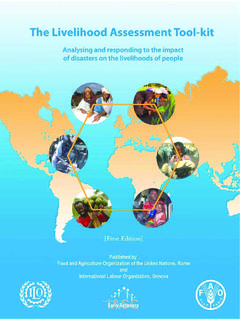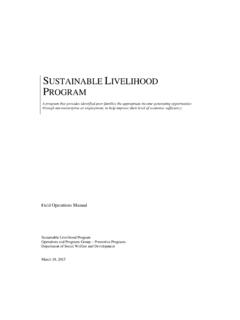Transcription of CHAPTER ONE Basic concepts of livelihood and food security ...
1 1 CHAPTER ONE Basic concepts of livelihood and food security livelihoods : origin, definition and concept livelihood is defined as adequate stocks and flows of food and cash to meet Basic needs. security refers to secure ownership of, or access to, resource and income-earning activities, including reserves and assets to offset risk, ease shocks and meet contingencies. Sustainable refers to the maintenance or enhancement of resource productivity on a long term basis. A household may be enabled to gain sustainable livelihood security in many ways-through ownership of land, livestock or trees; rights to grazing, fishing, hunting or gathering; through stable employment with adequate remuneration; or through varied repertoires of activities. According to Chamber and Conway (1992), a livelihood comprises the capabilities, assets including both material and social resources and activities required for a means of living.
2 A sustainable livelihood is sustainable when it can cope with and recover from Stress and shock, maintain or enhance its capabilities and assets both now and in the future, while not undermining the natural resource base. A person's livelihood refers to their "means of securing the Basic necessities -food, water, shelter and clothing- of life". livelihood is defined as a set of activities, involving securing water, food, fodder, medicine, shelter, clothing and the capacity to acquire above necessities working either individually or as a group by using endowments (both human and material) for meeting the requirements of the self and his/her household on a sustainable basis with dignity. The activities are usually carried out repeatedly. For instance, a fisherman's livelihood depends on the availability and accessibility of fish.
3 According to Stage et al. (2002) household livelihood security is often influenced by the ability of the household to diversify livelihood sources and assets. This shows that the more livelihood strategy and asset (the bigger its capacity and asset) that have in the household are having a chance more secure livelihood than a household have less livelihood assets. 2 livelihood diversification refers to a household's attempt to reduce its vulnerability by having more than one livelihood activity. In a diversified household, if one productive activity does not provide enough, or fails completely, there are other sources of livelihood that the household can fall back on. They use their different capabilities and the tangible and intangible assets and entitlements to which they have access as the basis for different livelihood sources and activities.
4 livelihood context: livelihoods are formed within social, economic and political contexts. Institutions, processes and policies, such as markets, social norms, and land ownership policies affect our ability to access and use assets for a favorable outcome. As these contexts change they create new livelihood obstacles or opportunities. These include: Social relations: The way in which gender, ethnicity, culture, history, religion and kinship affect the livelihoods of different groups within a community. Social and political organization: Decision-making processes, civic bodies, social rules and norms, democracy, leadership, power and authority, rent-seeking behavior. Governance: The form and quality of government systems including structure, power, efficiency and effectiveness, rights and representation.
5 Service delivery: The effectiveness and responsiveness of state and private sector agencies engaged in delivery of services such as education, health, water and sanitation Resource access institutions: The social norms, customs and behaviors (or rules of the game ) that define people s access to resources Policy and policy processes: The processes by which policy and legislation is determined and implemented and their effects on people s livelihoods . livelihoods are also shaped by the changing natural environment. The quality of soil, air and water; the climatic and geographic conditions; the availability of fauna and flora; and the frequency and intensity of natural hazards all influence livelihood decisions. livelihood Interdependence One final important characteristic of livelihoods is their interdependence.
6 Very few livelihoods exist in isolation. A given livelihood may rely on other livelihoods to access and exchange assets. Traders rely on farmers to produce goods, processors to prepare them, and consumers to buy them. livelihoods also compete with each other for access to assets and markets. Thus 3 positive and negative impacts on any given livelihood will, in turn, impact others. This is a particularly important consideration when planning livelihood assistance. We consider livelihoods because more importantly, disaster affected populations have overwhelmingly identified livelihoods as their greatest recovery priority. livelihood recovery livelihood recovery is also a building process that takes place in a very dynamic environment. livelihood strategies must be able to adapt or change altogether as the surrounding conditions change.
7 Disaster assistance, across all sectors, also directly and indirectly impacts livelihood recovery, either enabling or impeding it. A phased Approach to livelihood Programming livelihood provisioning: livelihood provisioning is a set of relief based interventions that involve providing food and meeting other essential needs for households to maintain nutritional levels and save lives. Interventions of this type usually entail food and health relief for people in an emergency or people who are chronically vulnerable. livelihood protection: livelihood protection is a set of interventions that involve protecting household livelihood systems to prevent an erosion of productive assets and replacing or rebuilding productive assets. These types of interventions entail timely food and income transfers; infrastructure repair, rehabilitation, and improvements, carried out through food- or cash-for-work or some other means; and replacement of assets such as tools, boats and seeds.
8 livelihood promotion: livelihood promotion is a set of development based interventions that involve improving the resilience of household livelihoods so that food and other Basic needs can be met on a sustainable basis. Interventions of this type entail strategies such as diversifying livelihoods strategies; creating alternative income-generating activities; providing financial services, such as loans and insurance; and strengthening markets. Different methods, capacities, resources and timeframes are required to achieve the different objectives of livelihood provisioning, protection, and promotion. livelihood provisioning is a relief-based objective, which relies on swift response and the logistical capacity to deliver critical 4 provisions. livelihood protection is aligned with the recovery phase and requires careful and complex assessment and benefits from local contextual knowledge.
9 livelihood promotion is the transition from recovery efforts to development goals and requires the long term commitment of governments and other development actors. Issue 1: Enabling livelihood protection Cash grants and material assistance Creating temporary income-earning opportunities Procuring local goods and services Using market chain analysis to reinvigorate markets Issue 2: Improving livelihood promotion Engaging development actors in livelihood programming Building and strengthening micro-finance institutions Intervening in markets Ensuring economic and environmental sustainability Vulnerability, coping and sustainable livelihoods Vulnerability has been defined as a state of defenselessness, insecurity and exposure to risk, shocks and stress. It is different to poverty itself which refers to a lack or wants. In fact, there are two sides to vulnerability - externally, an individual or household may be subject to shocks or risk, while internally, the means to cope may be inadequate or non-existent.
10 The concept of ' livelihoods ' usefully integrates poverty and vulnerability. A ' livelihood ' may be defined as a level of wealth and of stocks and flows of food and cash which provide for physical and social well-being and security against becoming poorer. Poverty lines and other definitions of deprivation based only on flows ( income), and not on assets or reserves which can be disposed of in emergencies sickness, drought, are less satisfactory. Assets such as land, trees, livestock etc. reduce vulnerability and act as buffers to shocks . As with aspects of nutrition such as the status of women and seasonality, for example, sustainable 5 livelihoods should not merely be dealt with as an appendage to an analysis of deprivation - these are integral threads that are better understood as pervading all aspects of the problem. The strength of a given livelihood is not only measured by its productive outcomes, but equally by its resilience to shocks, seasonal changes and trends.














